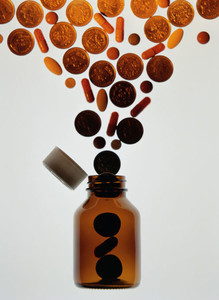Italian researchers have completed a retrospective cost analysis comparing the use of filgrastim biosimilars with the originator granulocyte colony-stimulating factor (G-CSF). Their retrospective, single institution study of 56 lymphoma and myeloma patients concluded that treatment with the biosimilars Tevagrastim and Zarzio was associated with cost reductions of 56% and 86%, respectively.
Cost of filgrastim biosimilars compared to originator filgrastim
Biosimilars/Research
|
Posted 05/06/2015
 0
Post your comment
0
Post your comment

Simona Bassi and co-authors at the Guglielmo da Saliceto Hospital in Piacenza, Italy, analysed data from patients treated between 2011 and 2014 who had undergone autologous haematopoietic stem cell transplantation (HSCT) at the Guglielmo da Saliceto Hospital. A total of 25 patients had non-Hodgkin’s lymphoma, 25 patients had multiple myeloma and six patients had Hodgkin’s disease.
Of these, 17 patients received Tevagrastim (Filgrastim XM02) (Teva) and 39 patients received Zarzio (Sandoz) [1].
For the cost analysis, the authors considered the mean inpatient cost of each of the filgrastim biosimilars, calculated from the total number of vials used by the patient to achieve bone marrow recovery, and compared this with the predicted cost of using the originator product Neupogen (Amgen). The cost of one vial of Tevagrastim at the Guglielmo da Saliceto Hospital was Euros 34.10 (US$42.51), while one vial of Zarzio cost Euros 10.85 (US$13.5). This was 56% and 86% cheaper, respectively, than one vial of Neupogen, which cost (Euros 77.53/US$96.65).
Looking at the total number of vials used of the single types of filgrastim biosimilar, the mean cost of G-CSF support in the Tevagrastim group was Euros 250.73/patient (US$312.6), while the mean cost in the Zarzio group was Euros 76.22/patient (US$95). The total cost of treatment with Zarzio for one patient was the same as the cost of just one day of therapy with the originator.
Although the study was small and retrospective, conclude the authors, the potential for such reduced hospitalization costs makes the case for prospective studies to further investigate these findings.
It has been estimated that biosimilars could cut spending on biologicals in the US by US$44 billion over the next decade [2].
Conflict of interest
The authors of the research paper [1] declared that they had no conflicts of interest.
Related articles
Safety of filgrastim biosimilars following stem-cell transplantation
Efficacy of filgrastim biosimilars following stem-cell transplantation
How safe is Zarzio after five years’ clinical experience?
Biosimilar filgrastim provides cost savings for treating febrile neutropenia
Editor’s Comment
Readers interested to learn more about cost savings to be made with biosimilars are invited to visit www.gabi-journal.net to view the following manuscript published in GaBI Journal:
Norway, biosimilars in different funding systems. What works?
Readers interested in contributing a research or perspective paper to GaBI Journal – an independent, peer reviewed academic journal – please send us your submission here.
References
1. Bassi S, Stroppa EM, Moroni CF, et al. Safety and efficacy of granulocyte colony-stimulating factor biosimilars in engraftment after autologous stem cell transplantation for haematological malignancies: a 4-year, single institute experience with different conditioning regimens. Blood Transfus.2015 Feb 2:1-6.
2. GaBI Online - Generics and Biosimilars Initiative. Biosimilars could save US$44.2 billion over 10 years, [www.gabionline.net]. Mol, Belgium: Pro Pharma Communications International; [cited 2015 Jun 5]. Available from: www.gabionline.net/Reports/Biosimilars-could-save-US-44.2-billion-over-10-years
Permission granted to reproduce for personal and non-commercial use only. All other reproduction, copy or reprinting of all or part of any ‘Content’ found on this website is strictly prohibited without the prior consent of the publisher. Contact the publisher to obtain permission before redistributing.
Copyright – Unless otherwise stated all contents of this website are © 2015 Pro Pharma Communications International. All Rights Reserved.
News
FDA approves six denosumab biosimilars
EMA recommends approval for four biosimilars targeting three therapies
General
Samsung Bioepis wins Pyzchiva case; Regeneron patent rulings threaten foreign biosimilars
Chinese biosimilars go global: growth, partnerships, and challenges
What is the future for the US biosimilar interchangeability designation

Biosimilars/Research Posted 05/06/2025
Biosimilar clinical efficacy studies: are they still necessary?

Biosimilars/Research Posted 27/05/2025
The best selling biotechnology drugs of 2008: the next biosimilars targets








Post your comment